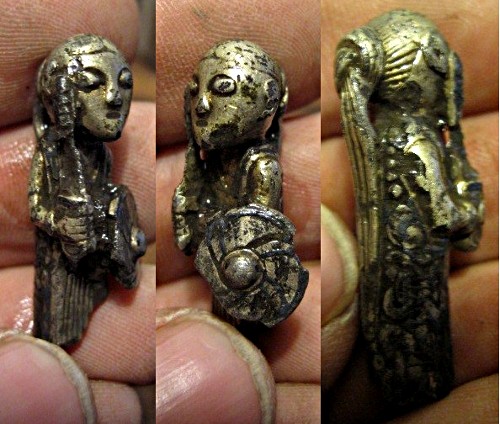Vikings are generally seen as dirty, bloodthirsty brutes, but is that really the truth? The answer can be found in complaints from contemporaries, in Viking graves and in the modern Scandinavian languages.

Imagine a Viking. What do you see in your inner eye? Do you see a dirty man with wild hair, beard all over his face, and a mean look? The mean look may be true, but the rest is not.
Vain Vikings
Vikings were actually vain.
- they washed at least every Saturday
- they obsessively combed their hair and beard and cut them in stylish hairstyles
- they often dyed their hair red or blond
- they were particular about their clothing
- and–surprising to most–they wore eye make-up.
What?! Did Vikings wear make-up?!
[Everyone who learns that Vikings wore make-up]
Yes, Vikings wore make-up.
Also, half of the Vikings were women so that dirty man you’re imagining may as well be a stylish and very clean woman. With a sword, mind you.
But the make-up? It was worn by men, too.
Were Viking men more feminine and Viking women more masculine than today?
How do we know that Vikings were vain?
Imagine a Viking grave. What do you think a true Viking was buried with?
A sword, you say? Yes, the Viking may have had a sword in the grave. Both men and women have been buried with swords, but far from all Viking graves have had swords in them.
Pottery? Yes, pottery is a good guess. Both men and women were often buried with pottery, but that’s also not the most common thing found in a Viking grave.
The item that has been found in most Viking graves is this: [DRUM ROLL]

Combs are the most common item found in Viking graves. Vikings carried their combs with them at all times and they used them to groom their hair and beard.
We don’t know much about the hair styles Vikings had, but if we look at artefacts and stone carvings we may get a picture of elaborate hair styles–like the ponytail knot below–and pointy beards–seen on the stone further below.


Saturday was washing day
The modern Scandinavian languages also tell a tale of the clean Vikings. Most of our weekdays are named after a Viking god or goddess, but Saturday stands out. We call it “lørdag” and it comes from the old Norse “laugardagr”.
Laugardagr means “pool day” or “bathing day”.
This means that Vikings bathed at least once a week. Maybe not something that impresses a modern person with their indoor plumbing and hot and cold running water, but for their contemporaries, washing once a week was extreme. Check out this complaint:
The Danes, thanks to their habit of combing their hair every day, of bathing every Saturday and regularly changing their clothes, were able to undermine the virtue of married women and even seduce the daughters of nobles to be their mistresses
John of Wallingford about Vikings in 1002
Read a romance with bathing Vikings
I’ve been fascinated by these bathing Vikings since my early teens. I’ve read about bath houses and bathing habits and imagined these men and women getting clean and having fun while washing themselves and each other (hey, let me have that bit of imagination).
My fascination has turned into writing. In my new Viking romance–which is out TODAY–there’s a hot and heavy scene in a bath house. Let me just say that Borghild isn’t amused by Eivind’s antics (but she is left hot and bothered).

Surprise… I used to spend nearly an hour grooming and prepping when going out. I had a permed and dyed (black) long hair styled with a hairdryer and copious amounts of hairspray. AND I used makeup. Mostly for eyes. Loved to use flashy outfits which stood out.
And I used my looks and smooth talk to seduce even married or hitched women. But only if their relationship was violently bad or screwed up by some religious cult.
Am I a Viking? Maybe, but I consider myself on the broader scale a Varangian and a Northman. It was the end of eighties and early nineties. So I would be called a glam metal rocker.
Funny, ain’t it? Some things never change. I’ll be sure to grab your book, and I expect Last Kingdom level historical accuracy.
P.S. Our saturday is lauantai. I don’t know if any linguistic research has been done on this. But lauan might suggest the modern laudan, (of) a plank. And the plank seats of a sauna are called lauteet. Saturday sauna is still a concept.
Sauna was in some ways a holy place, sometimes referring to spiritual purification. But above all it was always the cleanest place in any homestead with hot water readily available. That’s why before hospitals, universal health care and such, Finnish women gave birth in sauna.